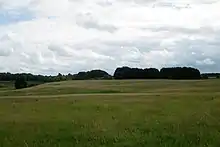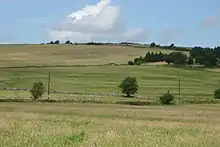Charterhouse (Roman town)
Charterhouse was a town in the Roman province of Britannia. Its site is located just to the west of the village of Charterhouse-on-Mendip in the English county of Somerset.

Its Latin name may have been Iscalis, but this is far from certain.[1] Based on inscriptions on a pig of Roman lead BRIT. EX. ARG. VEB, meaning "British (lead) from the VEB... lead-silver works", the Roman name has been reconstructed as Vebriacum (with Iscalis more plausibly placed at Cheddar).[2]
It is associated with the Iron Age hill fort, Charterhouse Camp. The Roman landscape has been designated as a Scheduled Ancient Monument.[3]
Mining settlement

The settlement grew up around the north-western edge of prehistoric lead and silver mines, which were exploited by the Romans.[4] Mendip lead ore had up to 0.4% silver content, which the Romans used to pay the army.[5] Extraction is thought to have begun as early as AD 49[6] (although the evidence of dateable lead ingots found in the neighbourhood has recently been questioned.[7]) At first the lead and silver industries were tightly controlled by the Roman military (in the south-west, by the Second Legion[8]) and there was a small 'fortlet' adjoining the mines during the 1st century, which may, however, have been little more than a fortified compound for storing lead pigs.[9] After a short time, the extraction of these metals was contracted out to civilian companies, probably because of low silver content.[10] Smelting was undertaken on site where industrial workshops have been excavated,[11] and the metal exported along a minor road to the Fosse Way, and probably through a small inland port at nearby Cheddar.[8]
Amphitheatre

An amphitheatre stood west of the settlement.[12] It is the only one in England to exist at a lead mine and is additional evidence of the importance of Mendip lead to the Romans.[13] It measures 32m x 24.4m and the banks for the seating survive 4.5m above the arena. It was surveyed in 1909. It was probably a place of entertainment for the soldiers at the Roman fort which was established here.[14]
References
- Rivet, A. L. F.; Smith, Colin (1979). The Place-Names of Roman Britain. London: B. T. Batsford.
- Costen, Michael (1992). The Origins of Somerset. Origins of the Shire. Manchester: Manchester University Press. p. 28. ISBN 0-7190-3675-5.
- Firth, Hannah (2007). Mendip from the air. Taunton: South West Heritage Trust. ISBN 978-0-86183-390-0.
- "Charterhouse on Mendip Roman Mining Settlement". Pastscape. English Heritage. Retrieved 22 February 2015.
- Elkington, H D H (1976). "The Mendip Lead Industry". The Roman West Country: Classical Culture and Celtic Society.
- Havinden, Michael (1981). The Somerset Landscape. The making of the English landscape. London: Hodder and Stoughton. pp. 58–59. ISBN 0-340-20116-9.
- Whittick, G. Clement (1982). "Roman Lead-Mining on Mendip and in North Wales". Britannia. 13.
- Aston, Mick; Burrow, Ian (1982). The Archaeology of Somerset. Taunton: Somerset County Council.
- De la Bedoyere, Guy (2006). Roman Britain: A New History. London: Thames & Hudson.
- "Major Romano-British Settlement Charterhouse on Mendip, Avon". Roman Britain.
- "Charterhouse". Big Roman Dig. Retrieved 28 October 2006.
- "Monument No. 194337". Pastscape. English Heritage. Retrieved 22 February 2015.
- Dunning, Robert (1983). A History of Somerset. Chichester: Phillimore & Co. ISBN 978-0-85033-461-6.
- Adkins, Lesley and Roy (1992). A field Guide to Somerset Archeology. Stanbridge: Dovecote press. pp. 37–39. ISBN 0-946159-94-7.